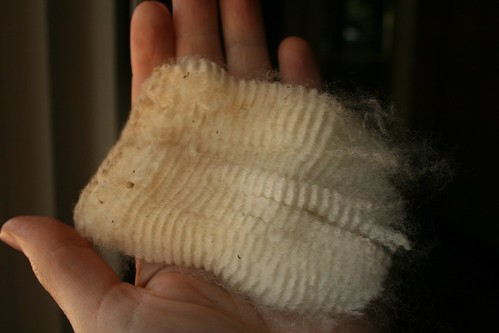I recently had a conversation with my father about my new Etsy shop,
AliCat Fiberarts, where I've started selling my handspun yarn and hand dyed wool for spinning. He was wondering about the market for such products. He wasn't being critical - just curious. It was one of those conversations where I need to explain something to an "outsider" - in this case not only a non-spinner, but a non-fiber person! I'm going to attempt it again here, drawing some parallels to food and gardening, as those topics have become more mainstream.
Once upon a time, when most people grew most of their own food, it mattered what type of tomato you were growing or what breed of chicken you raised. It wasn't so much a matter of Good or Bad, more of Good for
this purpose and Bad for
that one. With the advent of Industrial Agriculture (among other things) that idea had largely disappeared. Now, with the current trend toward Farmer's Markets, home gardens, and heirloom varietals, these topics are in the news, so that many non-foodies know something about them, even if it's not a personal interest.
What does this have to do with spinning? The same idea that The Variety Matters also holds true for sheep and other fiber-bearing animals. Just as there are hundreds of varieties of tomato, there are hundreds of breeds of sheep (and yes -to the already-spinners out there - I know there's a lot of stuff to spin besides wool, but I'm leaving that for another post!). Unfortunately, the average yarn-user's knowledge and understanding of sheep breeds has followed the same path as the supermarket produce shopper. Aside from the "brand recognition" of Merino and Shetland (both breeds of sheep), wool is wool, right? That itchy stuff that you have to wear a heavy turtleneck under? Well - not really -no!
All sheep have wool, but different breeds have slightly different wool. To vastly oversimplify things, all sheeps' fleeces fall somewhere on a spectrum of fine to coarse, and short to long. Fineness is based on the diameter of the fibers. Length is the length of the fibers (usually one year's growth) - wool parlance for this is "staple length." The finer a wool is, the softer it is. Conversely, the coarser a wool is, the rougher and more prickly it feels, and it's this "prickle factor" that gives wool a reputation for being itchy. Wool, from an industrial perspective, is a byproduct of the lamb industry. With the exception of Merino and other specialty breeds, ranchers make their money off meat. Most sheep need to be shorn annually for health reasons, and in most cases the shepherd sends all the wool to the local "wool pool" which will have fleeces from several breeds, all of varying quality, all mixed together. This is where most generic "wool" for the textile industry comes from. Naturally it's likely to be itchy!
Merino is the Gold Standard in soft, fine wool. Most people could wear Merino underwear and be perfectly comfortable and non-itchy. At the other end of the spectrum there are breeds like Lincoln, which have long, coarse staples, and make excellent rug yarn - but you wouldn't want it in a turtleneck. And here you see your tradeoff. Merino is nice and soft and comfy - but you certainly wouldn't want to make a rug out of it. The fine fibers that make it so soft don't stand up to that kind of wear. You'd have holes in your rug in no time. The nice sturdy fibers that wear like iron (the "rug wools") would be way too itchy for clothing.
Here's where we get back to the original subject. Why spin your own yarn? Because there are lots of sheep breeds that fall in different places all up and down this spectrum of fine-to-coarse. Just like growing your own vegetables or sewing your own clothes, when you spin your own yarn you can tailor it to the end use in a way that's difficult to do with generic off-the-shelf wool. Sure it's easy to find Merino yarn - that's one of the few breeds available by name. But suppose you want to crochet a hearth rug or make potholders? Pick a coarser longwool breed. Knitted and felted clogs, slippers and handbags are also becoming popular - you can choose something in the middle that's not too prickly on your feet, but will still survive being walked on. Sure you can use Merino for socks - it'll be comfortable, but I hope you like darning! Pick something like Blue-faced Leicester, which is a longwool breed, but still very soft. Once you start exploring the characteristics of different breeds it can be hard to stop! You start giving the classic spinner's justification of "Yes I know I have ten fleeces in the closet, but I don't have
that one yet!" In the end it all becomes useful stuff. The more we know and understand, the more useful and long-lasting our stuff will be!


























































